 Three distinct markets of electric-drive vehicles are expected to gain momentum in the coming years: conventional gas-electric hybrids, plug-in hybrids, and all-electric cars. Many analysts believe that Prius-style hybrids will experience the most dramatic growth, followed by plug-in hybrids—with all-electric cars selling at lower numbers.
Three distinct markets of electric-drive vehicles are expected to gain momentum in the coming years: conventional gas-electric hybrids, plug-in hybrids, and all-electric cars. Many analysts believe that Prius-style hybrids will experience the most dramatic growth, followed by plug-in hybrids—with all-electric cars selling at lower numbers.The market for all-electric cars may be limited due to limited driving range. It’s not surprising that Fisker Automotive and Tesla Motors—two California-based makers of high-end electric-drive sports cars—are viewed as similar companies. Fisker makes an $87,000 plug-in hybrid and Tesla produces a $109,000 all-electric roadster. But Henrik Fisker, founder of the Southern California-based company that bears his name, this week was in Northern California where Tesla is based, to explain how and why the two companies are different.
To Fisker, it’s a matter of technology and market potential. “The full-electric car [like the Tesla Roadster] is a niche market. Plug-in hybrids have a much bigger market,” said Fisker, speaking at a meeting of the Western Automotive Journalists association. He added that the growth potential of the plug-in hybrid market is what has helped his company to secure venture capital financing for their project.
Considering the larger market for plug-in hybrids compared to electric cars, Fisker believes that his company has a better business model than his competitor. His current goal is 15,000 annual sales of the Fisker Karma, a four-door sleek sports car. Fisker's factory under contract in Finland—which also makes the Porsche Boxster and Cayman—can produce a maximum of 20,000 units annually. “We have a new business model. At 5,000 sales, we can make money,” which for now is fine with him.
But Fisker is already looking several steps ahead. “A growth strategy is the key to venture capital,” Fisker said. Even though the Karma isn’t due to hit the market until spring 2010, the company is planning its next vehicle. Fisker was light on details, but said it would be “lower in price, a mass market vehicle with high volume using common components with the Karma. There’s no reason we can’t eventually produce hundreds of thousands of cars a year.”
Despite Fisker’s statements, the two companies have followed nearly identical business plans thus far. Tesla has also raised significant venture capital, has plans for a future more affordable mass-market sedan, claims that profitability is possible with low sales volumes and hopes to use government loans to augment their venture capital. Just last week, Elon Musk, chief executive of Tesla, claimed that the company will become profitable this month, even though it has only sold about 500 units and is struggling to reach its production goal of 1,000 units per year.
If Fisker can make the transition to a more affordable mass-produced plug-in hybrid, its competition would shift from fellow start-ups to much larger companies, possibly even General Motors. Nevertheless, Fisker doesn’t see the Chevy Volt, a plug-in hybrid employing a technology design similar to the Fisker Karma, as competition.
“It’s a Chevy,” he said, suggesting that his luxury plug-in hybrid will be clearly distinguished from a mainstream brand like Chevrolet. There is some irony in his putdown of Chevy, because the Karma’s internal combustion engine is sourced from GM. The Karma will use the 2.0-liter turbocharged direct injection four-cylinder engine—currently found in the Pontiac Solstice—to recharge the vehicle’s batteries after approximately 50 miles of all-electric driving.
Source : Hybridcars.com, July 2nd, 2009

Aucun commentaire:
Enregistrer un commentaire